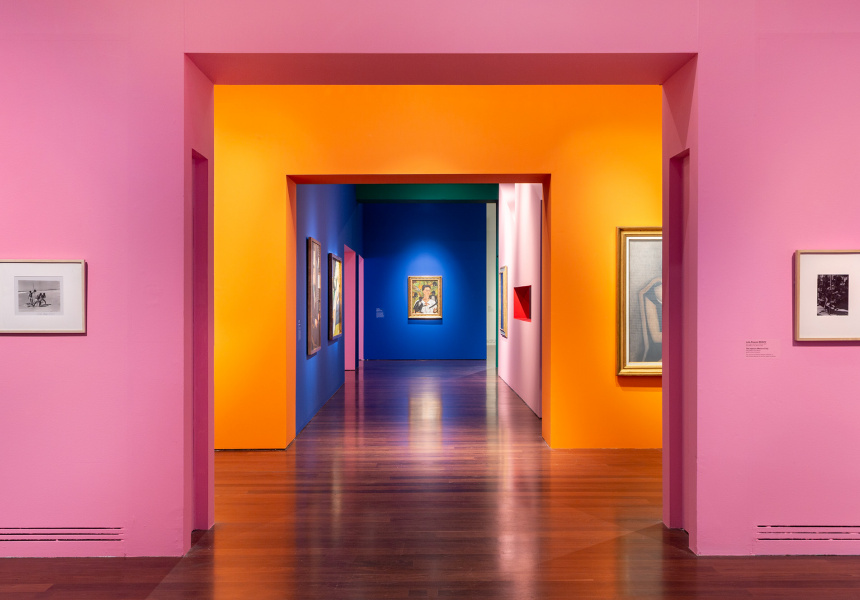With her steely gaze, iconic brow and stark portrayals of pain, Frida Kahlo’s self-portraits are some of the most visually arresting of all time. Her life, struck with tragedy and misfortune – from her childhood polio, to the bus crash that left her in lifelong pain (and galvanized her art practice) to her turbulent relationship with artist Diego Rivera – often takes up most of the conversation. But as Art Gallery of South Australia curator Tansy Curtin tells it, her personal allure wouldn’t have endured so long without her incredible body of work.
“We get quite weighed down by the story of Frida Kahlo, but in this moment we’re reminded why we’re here,” says Curtin, glancing up at Kahlo’s famous 1943 work Self Portrait With Monkeys. “Because she was an amazing artist.”
Kahlo’s radical exploration of identity and unflinching self-portraits are on show in the Australian-exclusive exhibition, Frida & Diego: Love & Revolution, which opened at AGSA on the weekend. Alongside iconic works by Kahlo and Rivera, the major exhibition features pieces by many of their contemporaries, including Manuel and Lola Álvarez Bravo, Miguel Covarrubias, María Izquierdo, Carlos Mérida, David Alfaro Siqueiros and more. It’s said to be the most comprehensive display of Mexican modernism ever seen in Australia.
Through more than 150 works, including original paintings, works on paper, photographs, and video from the unrivaled personal collection of Jacques and Natasha Gelman – passionate art collectors and friends of Kahlo and Rivera – the exhibition immerses visitors in Mexico’s art world of the early- to mid-20th century. The iconic works are linked through a larger narrative that’s spun around the history and culture of Mexico, beginning with the Mexican Revolution.
“This is a wonderful moment to celebrate the incredible artistic legacy of these artists but also remind us that this is continuing in Mexico – there’s a wonderful, vibrant community of incredible artists,” says Magda Carranza de Akle, curator of the Jacques and Natasha Gelman Collection of Mexican Modernism, who’s currently in Adelaide for the exhibition.
The artworks are given even greater life through a bright, bold architectural gallery design by Grieve Gillett Architects that transports visitors into the world of Kahlo and Rivera with vibrant colour and allusions to the couple’s home, La Casa Azul (The Blue House). A blue wall running through the centre of the exhibition, separated into three sections, also references Kahlo’s spine, which was broken in three places during the fateful bus crash.
After that accident, Kahlo was confined to her bed for three months – a period referenced in the exhibition with the installation of a four-poster bed – so her parents put a mirror above it, and she began painting self-portraits during her recovery.
“She turns the gaze back on herself, which is really incredible … and traditionally a very masculine thing to do, if you think about the artists that have painted the most self-portraits through history,” says Curtin.
“While her physical body may have limited her, Kahlo’s resilience and creativity soared, resulting in bold and commanding statements which retain their social, cultural and feminist potency,” she says.
It’s little wonder her work still resonates so mightily – Kahlo was an artist (and a human) ahead of her time.
“She did things back then that no one did,” says Carranza de Akle. “She did a lithograph on her miscarriage, she went to her last exhibition in a stretcher, she got divorced, which was not a thing you did back then, she had bisexual relationships. She was honest about these things and never hid them. She had strength and honesty and she’s a fighter … I think that’s why she’s still current.
“But the important point is if she had not been a very good artist, we wouldn’t be talking about her life. Foremost, she produced incredible art.”
Frida & Diego: Love & Revolution is on at AGSA until September 17. A full program of events during the exhibition season, including a multi-course dinner by La Popular Taqueria, is available online.
agsa.sa.gov.au

